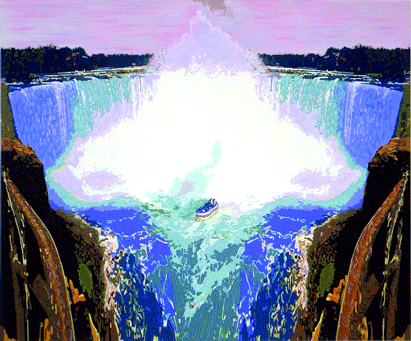Cadence Giersbach incorporates her Photoshop past into intensely focused paintings
Cadence Giersbach returns to Williamsburg’s Roebling Hall for her second solo show with ten great paintings. It’s been nearly four years, but it’s definitely been worth the wait.
Ten years ago, Giersbach was among a few young artists seriously investigating the use of digital tools in the context of painting and drawing. Back then, she projected directly onto walls Photoshopped imagery traced and painted larger than life. Her paintings and installations took on themes of nature versus culture processed through the filters of the digital desktop. “Topicalia,” her first solo show at Roebling Hall, employed intensely plastic materials as the output of her psychedelic “digitalia”––set against the ground of wall-sized murals.
“Niagara” is an exhibition of focused, mature paintings. Giersbach has clearly delved deeply into the process and subject of her work. All flashe on wood panel, they are just that––paintings. Gone are the expansive murals in the gallery context. This time Giersbach takes easel-painting straight on, allowing us to focus, as she does, on her subject—Niagara Falls.
Giersbach’s familiarity with Photoshop is now so embedded that the filters and tricks are simply part of her painting. She pulls down windows and key commands with the brush in hand. No projection necessary. And with this liberty other things happen.
“Niagara Factories,” 2004, is filled with tiny tender strokes of brickwork and brushy clouds, lapped and butted up against flat planes and morphed pools of a radiating ground. And there’s much more––the obsessive “more” that information technology implies. But still, the factories are intensely present, there to be considered between the ground of our idealized Niagara and its specific implications of nature and culture.
This specificity helps Giersbach’s project immensely, as she gets us to gaze upon this already problematic natural site through her own perceptual contradictions. Color and surface play an important role in the complexity of these contradictions. Warm russets and earthy moss tones argue with electric blues, near-neon greens and cherry reds. And the open, arid surface of the flashe presents an attractive artificiality that any plastic medium would only seal and gloss.
In “Maid of the Mist,” 2003, Giersbach gets to the heart of her subject. A tiny tourist boat steers into the base of the great falls. Dwarfed by a mass of surging natural forces, the vessel is stilled by a great white burn-out of digital information. Of course, we know this is the mist, zillions of tiny water droplets atomized from the falls. And yet it’s nothing a postcard, painting or jpeg could convey. You would have to be there. It’s this kind of presence these new paintings confirm, so don’t go to Roebling Hall’s Web site to see the work. Go to Williamsburg.
gaycitynews.com

































